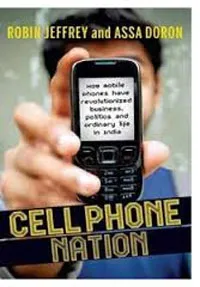[Book Review] Cellphone Nation: How Mobile Phones Have Revolutionised Business, Politics and Ordinary Life in India

2013 Hachette India http://www.amazon.in/Cell-Phone-Nation-Revolutionized-Business/dp/9350093545
8 chapters, 293 pages
This terrific book on the mobile revolution in India provides not just sound scholarship but also an engaging read for a broader audience, a rare double feat.
The writing style is a mix of journalistic reporting, media history, academic frameworks, and local travelogue. The middle of the book has 24 pages of colour photographs which provide glimpses into the street view of mobile life. (In the US market, the book is titled “The Great Indian Phone Book: How the Cheap Cell Phone Changes Business, Politics, and Daily Life.”)
The holistic treatment in the book by Jeffrey and Doron focuses on the broader mobile ecosystem in India and identifies entrepreneurial opportunities, ranging from setting up mobile operator networks to humble phone repair services.
Robin Jeffrey is a visiting research professor at the Institute of South Asian Studies and Asia Research Institute, National University of Singapore. Assa Doron is an Australian Research Council Future Fellow in the College of Asia and the Pacific, Australian National University, Canberra. Doron is also author of “Caste, Occupation and Politics on the Ganges: Passages of Resistance.”
Jeffrey (with a background in politics) had been a teacher in Chandigarh for two years (1967-9), and Doron (an anthropologist) arrived decades later during the mobile phone boom – making for an interesting contrast in telecom experiences and analytical techniques. The book is as much about the older communication gaps in India as the newer media opportunities.
So why have these two foreign writers collaborated on a book about mobiles in India? Because it is a compelling story, not just due to the sheer size of India’s mobile market but the variety (in terms of languages and cultures) and power politics in society (gender, caste, class, family).
“Cheap mobile phones gave poor people a device that improved their chances in a hard world. And in India, because of long-standing discrimination and structures of authority, the mobile has proved even more disruptive than elsewhere,” the authors observe. India’s caste system has “no equivalent for endurance, complexity, and malleability.”
“The cheap mobile phone is the most disruptive device to hit humanity since shoes,” they add. According to the World Bank, the mobile phone network is the ‘biggest machine’ the world has ever seen.
In February 2012, India had more than 900 million telephone subscribers, 96 per cent of which were mobile phone subscribers. More people have access to mobile phones than toilets today. In contrast, in 1947, India had an estimated 100,000 phone connections, or a ratio of about 3,400 people per phone; in 2001, India had 4 million cell phone subscribers.
The eight hefty chapters in the book are divided into three sections: Controlling (media power), Connecting (retail, repairs), and Consuming (business, politics, gender, crime).
The material is thoroughly referenced: the footnotes and references alone make for a whopping 55 pages. Cited scholars include Manuel Castells, Howard Rheingold, Jonathan Donner, James Katz and Rich Ling.
Mobiles are bringing about new “expansion and reconfiguration” of social and organisational networks. Mobiles are being ‘domesticated’ into daily life and are a way of ‘performativity’ or a form of presentation by individuals to the world.
The book makes frequent comparisons between the rise of the automobile industry in the US and the mobile industry in India (especially with respect to creation of support services). A few mentions are also made of mobile impacts in other emerging economies (eg. m-Pesa mobile payment services in Kenya, use of mobiles for social and religious activities in Jamaica, and ‘mobile religiousity’ by Muslims in Indonesia).
Mobiles have had broad quantitative and qualitative impacts on life in India, as summarised in Table 1 below. The ability to communicate no longer depends on literacy, post offices, printing presses or TV studios. However, there are limits to radical change: for example, without capable institutions and well-drafted laws, citizen reports about crime captured via mobiles will not be enough to bring justice.
In the realm of politics, phone calls by party activists could “leap barriers imposed by illiteracy, bad roads, long bus rides, uncertain postal services, hostile neighbours” and mass media biases.
“The cheap mobile phone puts an immensely disruptive device within reach of the poor. It is small and discrete and can be hidden if necessary. And it enables connections and encounters that would previously have been impossible,” the authors observe.
“Caution and nuance are essential if we are to understand the downs as well as ups that technology brings,” the authors caution. The mobile phone improved some conditions in India, but did not re-order society. It is very easy to get ‘over excited’ by anecdotes of mobile empowerment by a few individuals and communities, the authors warn.
Table 1: Mobile Impacts in India
For those interested in the rise of the industrial powerhouses in the mobile industry and the accompanying politics of lobbying and corruption for spectrum acquisition and regulatory influence, the authors provide detailed coverage in the chapter aptly titled ‘Celling India.’ It covers the four phases of regulatory opening up of India’s telecom market from the 1990s onwards.
By way of historical context, the social inequities, early communication models and information gaps in India are covered in the opening chapter, starting off with messenger systems and then the telegraph, telephone, postcards, newspapers, radio, TV and PCOs (public call offices).
Issues which would have been interesting to add to this already comprehensive book are the rise of mobile startups in the content and workflow segments, and the newer kinds of devices such as tablets.
Trends and developments to watch in future include health impacts of mobile, replication and scaling of social change experiments, and governments schemes to accelerate ICT diffusion.
The book ends by observing how the globalising consumerist India will continue to clash with the realities of power structures in everyday life. Mobile phones have become a necessity and reality in just a decade, and it is sometimes easy to forget what life was like in the pre-mobile era.
[Follow YourStory's research director Madanmohan Rao on Twitter at http://twitter.com/MadanRao]


![[Book Review] Cellphone Nation: How Mobile Phones Have Revolutionised Business, Politics and Ordinary Life in India](https://images.yourstory.com/cs/wordpress/2013/08/bookcover.jpg?mode=crop&crop=faces&ar=16%3A9&format=auto&w=1920&q=75)




